culture, japanese festival, japanese food
Hinamatsuri: Japan’s Girls’ Day Explained
Kim Kahan
Posted on February 21, 2022
Share:
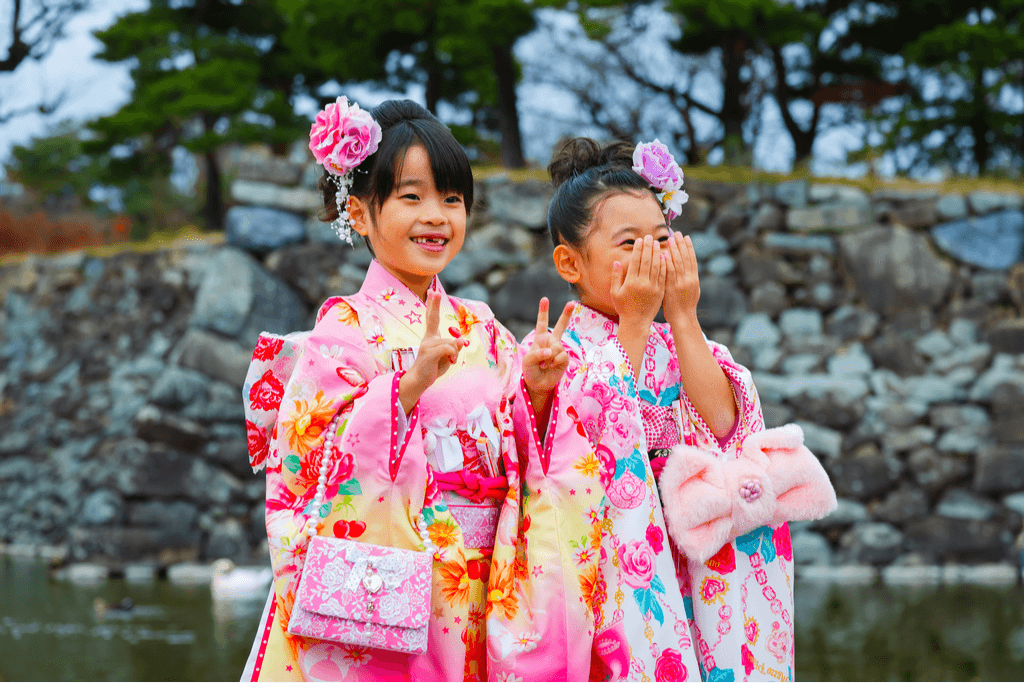
Since the Heian Period (794-1195), every year on March 3rd is Girls’ Day, Dolls’ Festival, or ‘Hinamatsuri’ in Japanese. Families in Japan wish for the health and prosperity of their young girls (generally up to 10 years old).
On Hinamatsuri, families often eat foods such as hina arare (colored Japanese rice crackers) and sakura mochi (rice cakes made with red beans and pickled cherry blossom leave) and display a set of dolls. In some rural areas, they continue a tradition of floating paper dolls down a river (nagashi bina) to part ways with all the misfortune from that year.
Origins of Hinamatsuri
Japan’s Hinamatsuri originates from a Chinese doll festival in which people send dolls down a river to carry away girls’ bad luck and misfortune. In the past, it was also the ‘peach season festival’ or ‘momo no sekku.’
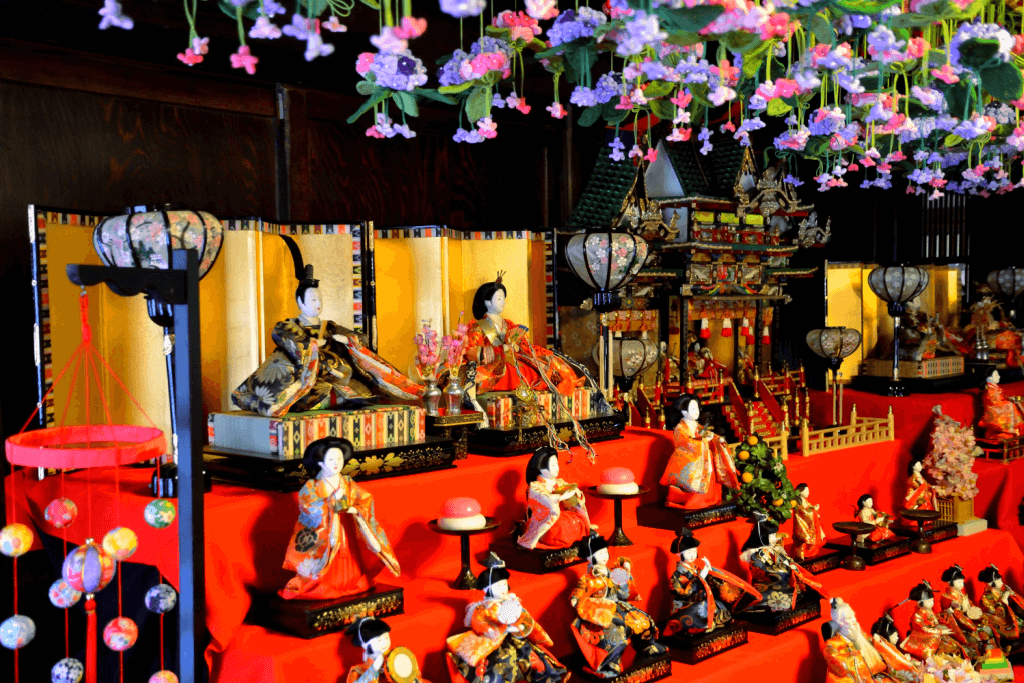
Celebrants then combined this with hina-asobi, which means ‘playing with dolls,’ a popular pastime among aristocratic children. Soon, this combined with the Chinese custom of floating dolls down the river. By the Edo Period, Hinamatsuri spread across Japan.
This holiday generally involves displaying hina dolls that will protect the girls of the house by absorbing any misfortune for that year. Customs also include playing games together and eating yummy foods, which have come to be strongly associated with Girls’ Day.
Famous Hinamatsuri Festivals in Japan
Yanagawa City Festival (Fukuoka)
Yanagawa City in Fukuoka is a charming destination famous for its canal boat rides and traditional Japanese architecture. One of the city’s unique features is its sagemon ornaments, colorful paper streamers adorned with tiny dolls or figurines displayed in homes and shops during the Hinamatsuri Festival.
The sagemon ornaments in Yanagawa are particularly special because they are handmade by local artisans using traditional techniques passed down through generations. These intricate and eye-catching ornaments add a festive touch to the city’s lively atmosphere during the festival.
Visitors can take in the beauty of the sagemon ornaments while enjoying a leisurely boat ride through Yanagawa’s picturesque canals. Yanagawa City is a must-visit destination for anyone looking to experience the magic of Hinamatsuri in Japan.
Tomisake Shrine Festival (Chiba)
The Hinamatsuri Festival at Tomisaki Shrine in Chiba is a vibrant and colorful celebration held every year on March 3rd. One of the festival’s highlights is the display of over 30,000 hina dolls. The display is a sight to behold, and visitors come from all over to marvel at the dolls and participate in the festivities. The Hinamatsuri Festival is a beloved tradition in Japan and an excellent way to experience the country’s rich cultural heritage.
Makabe Hina Doll (Ibaraki)
The Makabe Hina Doll festival is an annual event held in Makabe, Ibaraki, and is considered one of the largest Hinamatsuri festivals in Japan. The festival takes place from mid-February to mid-March, attracting thousands of visitors yearly. One highlight is its display of over 15,000 hina dolls.
Visitors can marvel at the exquisite beauty of these dolls, which depict the imperial court of the Heian period. In addition to the hina doll display, the festival also features traditional Japanese performances and a variety of food stalls selling local specialties.
People can purchase their hina dolls and other traditional crafts at the festival. The Makabe Hina Doll festival is a beautiful example of Japan’s rich cultural heritage and love for Hinamatsuri.
Want to have your celebration at home? Check out Sakuraco! Sakuraco sends traditional Japanese snacks, sweets, teas, and even kitchenware from local makers that show off the seasons and flavors of Japan!
What Do Hina Dolls Symbolize?
A hina doll set is an ornament of at least two dolls – the Prince and Princess (or the Emperor and Empress, depending on the region). Families display these dolls from mid-February until the end of Hinamatsuri or until March 4th.
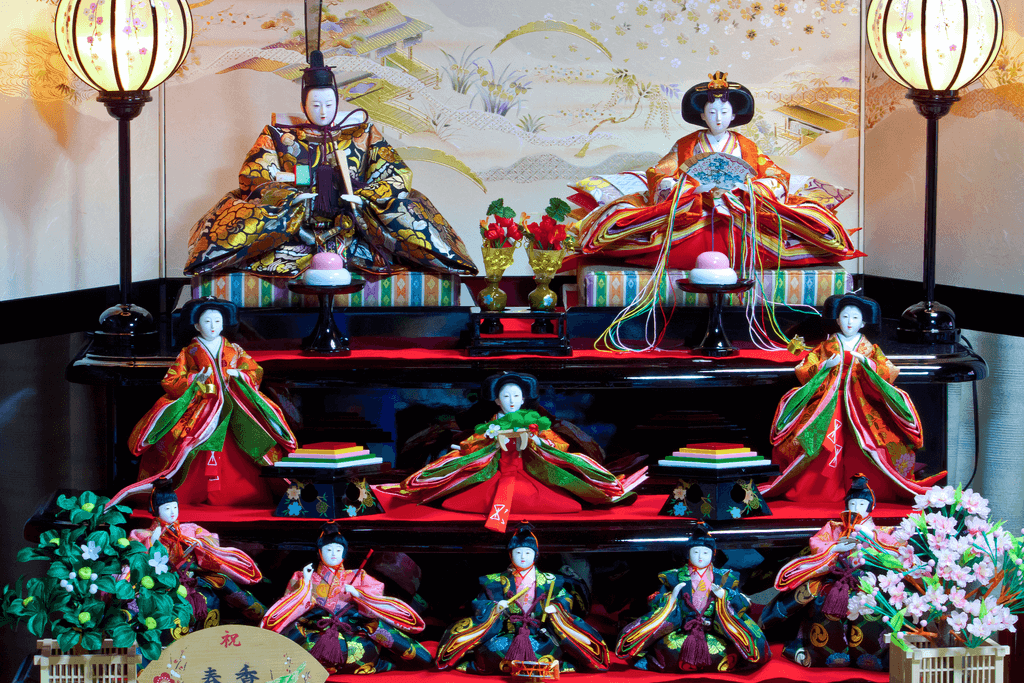
When the custom began in the Heian Period, people made their Hina dolls of paper or straw, but by the Edo Period, they started using ceramic. While some families get theirs from 100 yen shops such as Daiso, others keep expensive sets and add even more accessories as the girls get older.
Elaborate sets include the emperor, empress, attendants, and musicians, each on their little layer or tier.
The Hinamatsuri Doll Tiers
The highest amount of tiers is seven, all of which are on a red carpet, and each layer has a different meaning:
- The Prince and Princess: These two are the main feature in every Hina Doll set since they rule over everyone on the lower tiers.
- San-nin Kanjo (three servants): These servants, or ‘clever maidens,’ are said to serve the prince and princess at the top. Each carries a designated implement: a spoon, a platter, and a sake bottle.
- Go-nin Bayashi (five boy musicians): These young musicians are said to play Noh (a traditional Japanese stagecraft) music for the prince and princess, each playing a different instrument.
- Sui-jin (two guardians): The guardians are a young man and an older man, depicted as samurai in some editions or as government ministers in others.
- Shi-cho (three other servants): These servants are said to do the chores and often carry brushes, rakes, and dustpans. However, in specific locations, they hold equipment common to samurai but are still considered servants.
- Additional tiers: These are added to make up the lucky number seven and may contain decorations such as mini drawers and other furniture-like objects. Recently, newer sets can include miniature versions of more common traditional Japanese items like musical instruments or outdoor tea ceremonies.
Hinamatsuri Foods
The traditional colors for Girls’ Day are green (spring), pink (summer), yellow (fall), and white (winter). Celebrants include these colors in all of the hinamatsuri dishes and other activities.
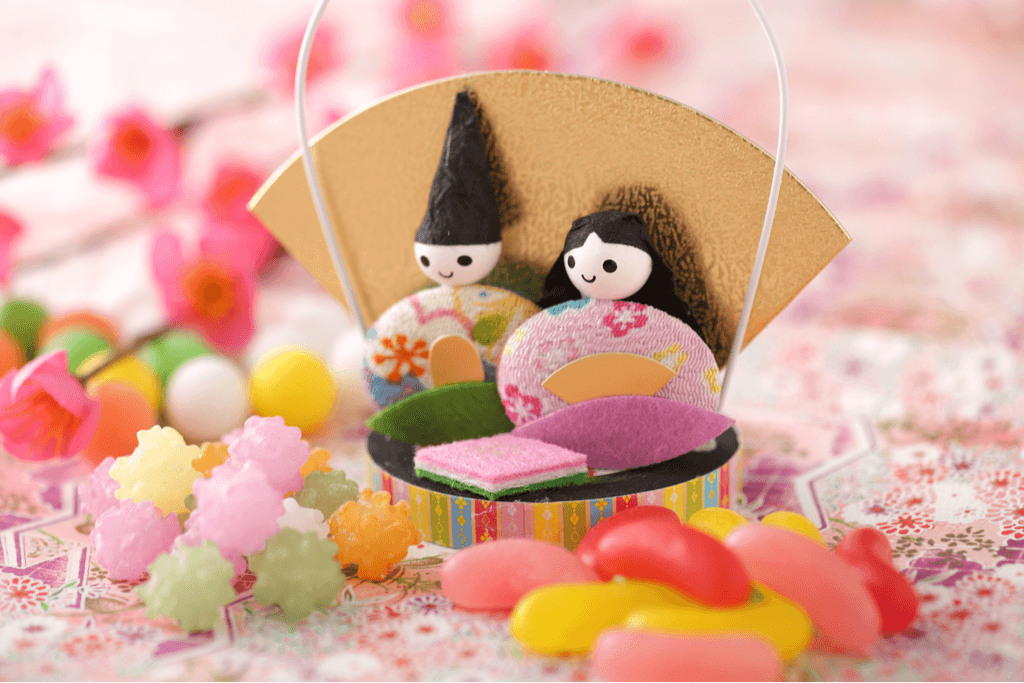
Arare
One of the Hinamatsuri foods is ‘arare‘ and consists of tiny balls of puffed, colored rice. They are either sweet (Kanto region) or savory (Kansai region). Their colors are white, pink, green, and yellow, and people use them with Hina dolls for decoration.
Hishi Mochi
Of course, it wouldn’t be a Japanese festival without special rice cakes to go with it. One of Hinamatsuri’s most common rice cakes is ‘hishi mochi.’
This mochi with layers of pink, white, and green colors from top to bottom. In recent years there has been a trend for copying the hishi mochi design. However, they use other ingredients to make desserts such as hishi mochi cheesecake!
Sakura Mochi
Even though cherry blossom (sakura) season doesn’t begin until April, sakura mochi is essential to Hinamatsuri. Sakura mochi is a pink, slightly gooey type wrapped in a pickled cherry blossom leaf. The red bean paste’s sweetness pairs well with the saltiness of the pickled cherry blossom leaves.
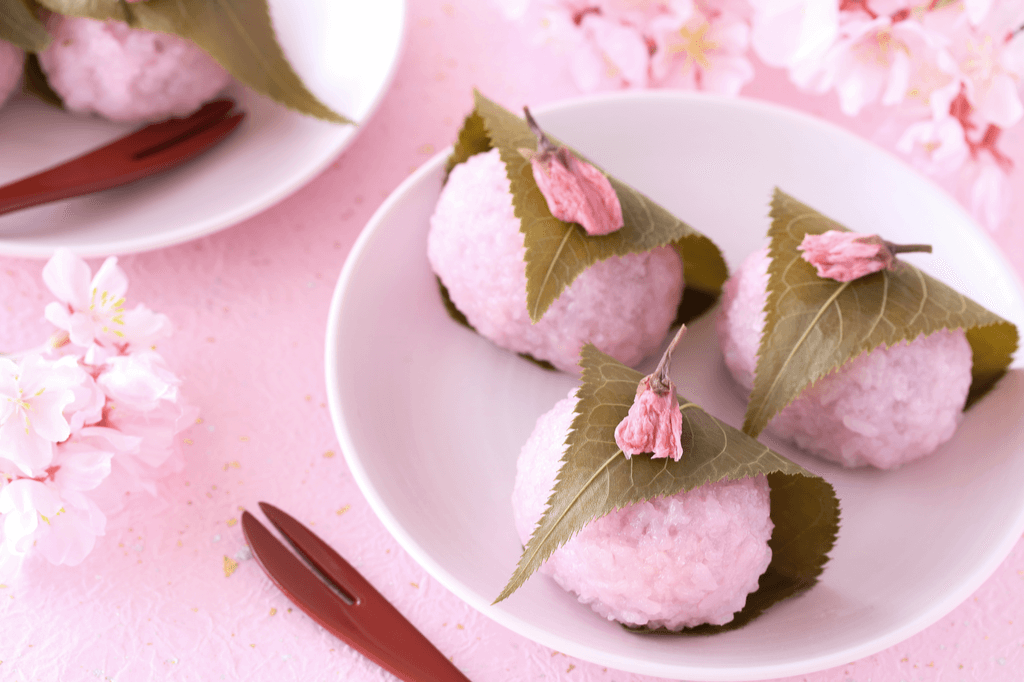
Hanami Dango
One of the reasons that Girls’ Day remains so popular is its proximity to flowers blooming. With the plum blossoms coming out, it is a great excuse to enjoy some hanami dango.
Hanami dango are cute, round rice cakes on a stick that feature Girls’ Day colors of white, pink, and green. This type of mochi dango can be eaten plain, as they are, or with a sweet dipping sauce. Many people will head to a park with friends and eat them with other common Japanese picnic foods.
Ushio Jiru
Ushio Jiru, or ‘clear clam soup,’ is another typical Girls’ Day food. The soup uses whole clams as its base and also for symbolism. They traditionally represent Girls’ Day because they are two halves of the same shell. It symbolizes good relationships or a good marriage in the future.
The soup consists of kombu dashi (a soup stock with a seaweed base) and only uses salt. The taste is subtle and a good accompaniment for Girls’ Day sushi.
Sushi
Dolls Festival even has sushi, specifically chirashizushi (mixed sushi). The sushi doesn’t have a set formula but does use specific ingredients.
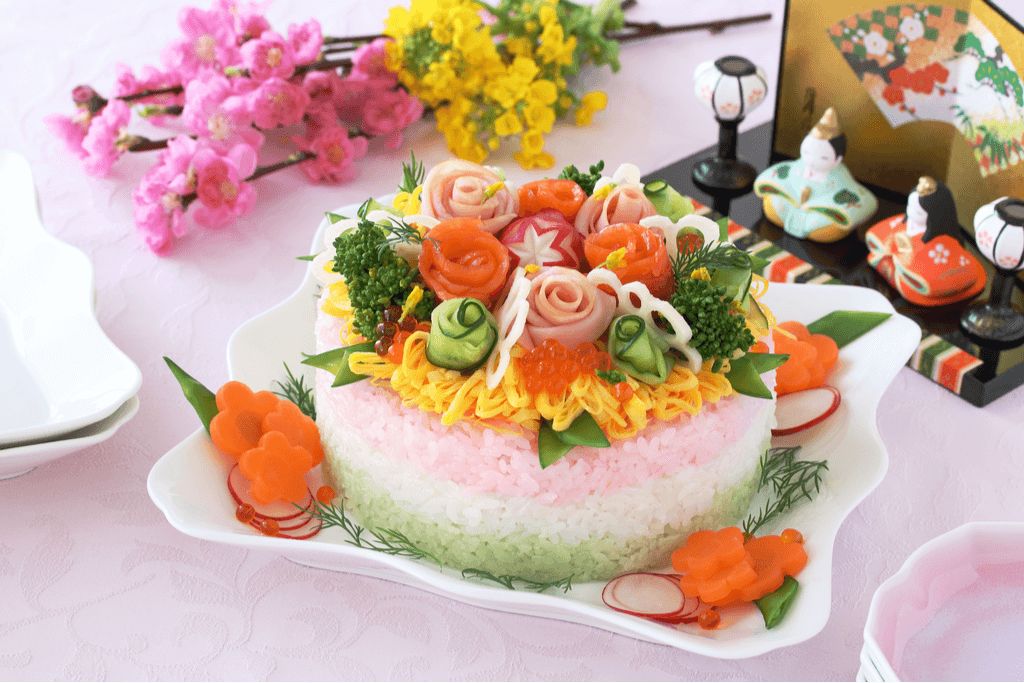
They are:
- Shrimp: for longevity, or to live until at least your back is hunched (or curled, like a prawn!)
- Lotus Root: for foresight.
- Beans: for health.
Hinamatsuri sushi is in the shape of a diamond and has three layers. There’s usually a yellow sliced omelet on top, then some shrimp, and green and pink colored rice on the bottom.
Let us know how you get on and what fun Girls’ Day sweets and snacks you have tried in the comments below.

Discover authentic flavors with Sakuraco
Get Sakuraco 

Discover authentic flavors with Sakuraco
Get Sakuraco 
Related Articles

Mount Fuji Snacks That You Need to Try This Summer!
Mount Fuji, Japan’s highest and most iconic peak, has long served as a muse not just for artists and poets, but also for confectioners. Its symmetry and snow-capped grandeur make it an ideal motif for culinary artisans nationwide. These treats capture the spirit of Fuji in edible form, reflecting regional ingredients, seasonal symbolism, and time-honored techniques.

Okinawa City is Home to Southeast Botanical Gardens!
The Southeast Botanical Gardens in Okinawa are one of the island’s most beautiful and relaxing destinations. In Okinawa City, they offer a lush escape filled with tropical plants, ponds, animals, and seasonal displays.

Mount Fuji Tour: Great Adventures Await You This Summer!
Mount Fuji is one of the most famous landmarks in Japan. People worldwide visit to see its beauty and enjoy exciting yearly outdoor activities!

Mikoshi: Why Are These Portable Shrines So Important?
Japan’s summer festivals are known for their energy, color, and tradition. And at the heart of many lies the mikoshi.



